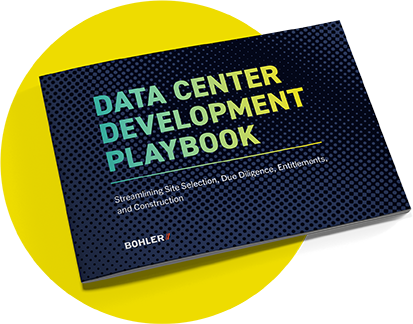Stay in the Know
Get our insights and latest news straight to your inbox.
To clearly define a “data center,” evolving zoning regulations are accompanying the expansion of data center development across Virginia, particularly into suburban and rural areas outside of Northern Virginia.
These changes acknowledge the unique nature of these facilities, distinguishing them from traditional industrial operations. The goal is to address the specific characteristics of data centers in a way that is more suitable for residents and adjacent communities. Data centers, unlike warehouse and distribution facilities, do not have daily truck deliveries and generate minimal traffic. However, the ongoing impacts from their specialized equipment and operating procedures, necessitate a regulatory approach.
The regulations strive to provide consistent rules for aspects such as architectural requirements, buffering, setbacks, screening, and stormwater management, streamlining the process for developers to adhere to these guidelines. Additionally, there is an emphasis on the importance of due diligence efforts to ensure potential political and environmental impacts are thoroughly assessed.

Official zoning ordinance updates have mostly occurred in Virginia. However, similar regulatory frameworks, including the requirement of sound studies, power availability and routing, and potentially stricter stormwater management facilities, are expected to be adopted in throughout Greater Richmond, and in regions outside of Virginia, across the Southeast.
With the right guidance from land development consultants like Bohler, jurisdictions can develop regulations that actually create opportunities for data center growth, rather than obstacles. Here are some of the advantages of more clearly defined zones, as well as tips for navigating them efficiently.
Updated data center zoning standards provide the considerable advantage of allowing design and development teams to anticipate and plan more effectively. Unlike the uncertainties associated with conforming to an industrial zone, a dedicated data center zone provides immediate clarity on requirements. This allows for streamlined negotiations with municipalities, reducing ambiguity, and expediting the development process.
How to Navigate: Engaging a knowledgeable land development consultant and site civil engineer early in the process is essential. Conducting thorough due diligence to identify site constraints, such as buffers, setbacks, screening, and stormwater management, along with any additional requirements like sound studies, is critical. This proactive approach ensures that the project aligns with regulatory expectations from the outset.
Communities can encourage more efficient clustering of data centers by delineating appropriate zones that are away from residential areas or do not obstruct a community’s open space. This not only helps jurisdictions maximize the number of potential data buildings, and therefore the associated tax revenue, but also gives them more control over the geographical spread of data center development. Given that data centers often seek locations away from densely populated areas, this zoning strategy can benefit both the industry and local community, helping to change the perception that some communities have about these uses.
How to Navigate: Early communication with the county or municipality is essential. Data center stakeholders can proactively contribute to discussions on optimal sites by understanding their local preferences. Engaging with site civil and land development professionals can help assess utility availability and potential yields, ensuring that chosen locations are feasible.
See Related: Addressing Community Concerns in Data Center Development
Municipalities can strategically strengthen their infrastructure by enacting zoning regulations that designate certain areas for data centers. In collaboration with the developers, authorities can use predefined locations to implement incentive programs to extend and upgrade power capacity, develop reclaimed water systems, and expand fiber-optic networks. This not only benefits data center developers but also gives the municipality the ability to strategically locate infrastructure such as overhead transmission lines.
How to Navigate: Effective communication within the design team is vital. By clearly articulating a willingness to engage in the planning of infrastructure improvements, developers can take advantage of available incentives. Collaborating with local authorities and understanding the broader development landscape may reveal opportunities for shared infrastructure extensions, fostering mutually beneficial arrangements, leaving the jurisdictional leaders with a positive mindset towards data development.
Across Central Virginia, including Greater Richmond, Bohler’s mission critical team is at the forefront of shaping new zoning regulations tailored to accommodate the growing demand for data center development. Our efforts are focused on improving the current perception around data center development, and highlighting the benefits that they can bring to the area, including job creation, increase tax revenue, site improvement and upgrades to the local infrastructure. By collaborating closely with county officials, Bohler is advocating for measures that strike a balance between attracting data center investment and addressing community concerns.
Moreover, Bohler is actively involved in identifying optimal sites for clustering data center development, leveraging synergies to enhance operational efficiencies and redundancies. Our expertise extends to providing recommendations for infrastructure enhancements, laying the groundwork for sustainable growth in the data center sector while fostering community harmony.
Evolving data center regulations bring about positive changes that can be navigated efficiently with strategic planning and proactive engagement with relevant stakeholders. By embracing these changes, the industry can continue to thrive, contributing to the economic growth of regions and improving overall infrastructure.
Ready to move forward with a data center development? Connect with our team.
Get our insights and latest news straight to your inbox.